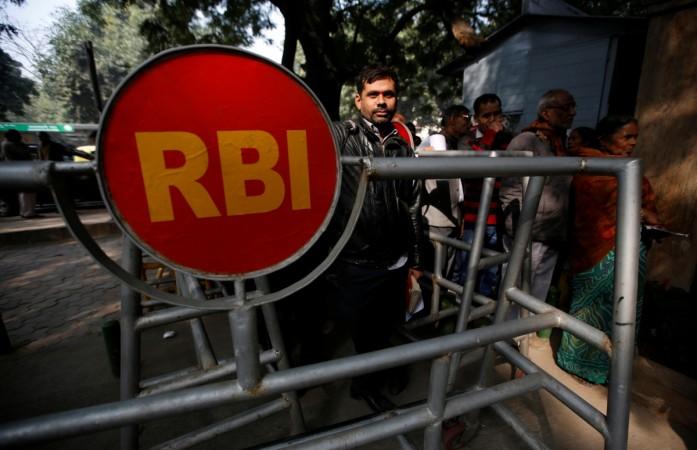
The slew of restrictions imposed on cash withdrawals by the Reserve Bank of India (RBI) on November 8 after demonetisation stand completely withdrawn with effect from today (March 13). It also coincides with the completion of elections to five states, the results for which were declared on March 11.
The curbs on cash withdrawals at ATMs were lifted in phases by the RBI. The first relaxation in cash withdrawals from Rs 2,500 per debit card per day (per savings bank account) to Rs 4,500 was made effective from December 30, 2016.
It was then increased to Rs 10,000 with effect from January 16, 2017. The weekly cash withdrawal limit was raised from Rs 24,000 to Rs 50,000 with effect from February 20.
In its March 10 note titled "Macroeconomic Impact of Demonetisation - A Preliminary Assessment", the RBI said:
"The analysis in this paper suggests that demonetisation has impacted various sectors of the economy in varying degrees; however, in the affected sectors, the adverse impact was transient and felt mainly in November and December 2016.
"The impact moderated significantly in January 2017 and dissipated by and large by mid-February, reflecting the fast pace of remonetisation. The latest CSO estimates suggest that the impact of demonetisation on GVA growth was modest.
"Currency squeeze due to demonetisation along with seasonal factors pushed food inflation significantly down but has not had much impact on inflation excluding food and fuel. A surge in deposits led to a sharp expansion in the consolidated balance sheet of scheduled commercial banks and created large surplus liquidity conditions. These were managed by the Reserve Bank of India through a mix of conventional and unconventional policy instruments."
Here is the sector-wise assessment of the RBI on Indian economy, Asia's third-largest:
Gold imports fell
India's gold imports declined to 661 tonnes in the calendar year 2016 (from 1,047 tonnes in 2015). Gold imports during 2016 were lower than the 10-year average (2005-06 to 2015-16).
After demonetisation, domestic demand for gold (or gold items) spiked suddenly, with buyers reportedly willing to pay huge premiums to dispose of old currency notes with jewellers. Reflecting this development as well as the seasonal jump, the volume of gold imports surged in November, even above the elevated October level.
Gold imports, however, declined sharply in December 2016 and January 2017. As around 80 per cent of the gems and jewellery purchases in India are made in cash, consumer demand was reported to have been impacted due to the cash shortage.
Fillip to digital modes of payment
An upshot of demonetisation was that the digital modes of payments picked up sharply. After demonetisation, there has been a significant emphasis on digital modes of payment.
It was boosted by reduction in the merchant discount rate (MDR) and point of sale (POS) fees; in addition to monetary incentives in the form of discounts and prizes.
The post-demonetisation spurt in activity among the major payment wallet companies such as Paytm, Free charge, Mobikwik, SBI's Buddy, and HDFC's Chillr has been phenomenal. Both app downloads and merchant acquisitions picked up.
The recent pick-up in digital payment activity is better reflected in the sequential growth in the months following demonetisation. The pattern of digital transactions in February 2017 over November 2016 shows that the growth rates surged in both value and volume compared with the corresponding period last year for most electronic modes of payment, even as there was some decline in the use of digital payments after December 2016.
FDI equity inflows suffered temporarily
Foreign direct investment (FDI) flows remained buoyant in November and December 2016. Portfolio flows (debt and equity) declined sharply from November 2016 to mid-January 2017, reflecting largely global factors. They, however, turned positive since the last week of January. There was an outflow in non-resident Indian (NRI) deposits of around US$ 18.5 billion during October to December 2016. This was mainly on account of redemption of foreign currency non-resident (FCNR) deposits raised in 2013 under the swap schemes.
Trade and tourism
There was a strong growth in foreign tourist arrivals of 13.2 per cent (year-on-year) during November 2016 to January 2017. October to March is the peak season for Indian tourism industry.
Non-gold imports, demand for edible oils were expected to slow down as domestic consumption and offtake have weakened post demonetisation.
Export growth, after having accelerated in September-October 2016, slowed in November 2016 (2.4 percent in dollar terms on a y-o-y basis) as shipments, especially from some labour-intensive sectors, were adversely affected by demonetisation. Export growth recovered in December 2016 and January 2017 to 5.5 percent and 4.3 percent, respectively.
Mutual funds became attractive
Reduction in deposit interest rates by banks after demonetisation enhanced the relative attractiveness of debt oriented mutual funds (MFs). As a result, there were net inflows in income/debt schemes during November 2016-January 2017 in contrast to net outflows during November 2015-January 2016.
Conclusion
Overall, the impact of demonetisation on the real economy has been transient, given the information available so far. The analysis in this paper suggests that demonetisation impacted various sectors of the economy; however, the adverse impact, in general, was short-lived as it was felt mainly in November and December 2016. The impact moderated significantly in January and dissipated by and large by mid-February 2017, reflecting an accelerated pace of remonetisation.














